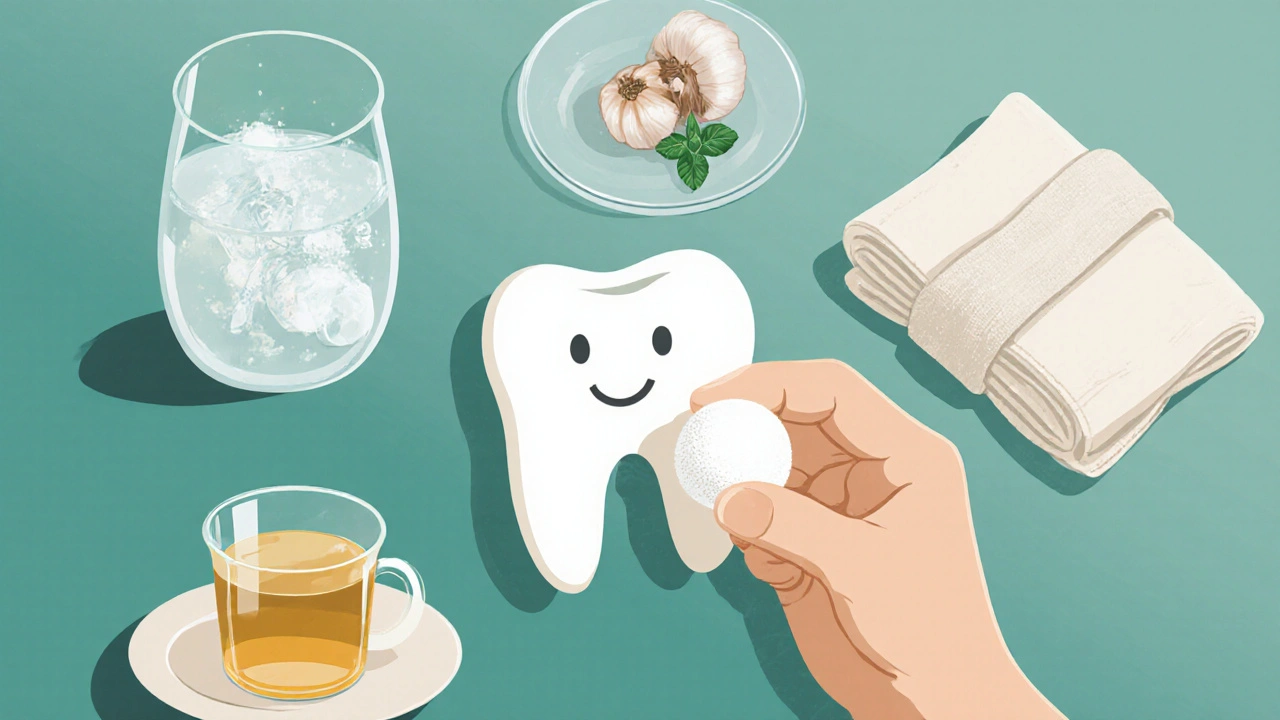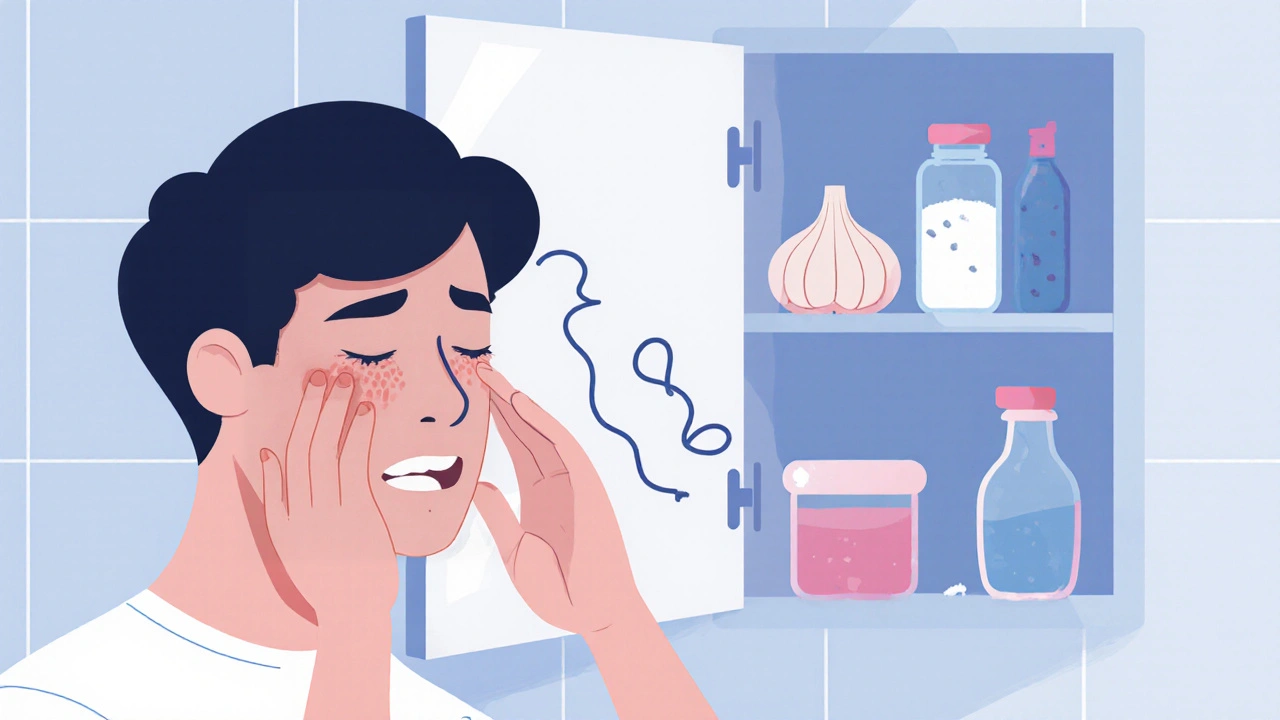Toothache Relief Guide
Select your symptoms to get personalized recommendations for the most effective toothache relief remedies from the article.
Symptom Assessment
These remedies provide temporary relief only. If pain persists for more than 2 days or if you experience swelling, fever, or pus, seek professional dental care immediately.
How to Use These Remedies Safely
-
Short Duration:
Apply each remedy for no more than 5-30 minutes to avoid irritation.
-
Test First:
Always test small amounts on the inside of your cheek before applying to sensitive areas.
-
Follow Instructions:
Follow the exact preparation and application guidelines from the article.
When a sharp pang hits your jaw out of nowhere, it’s easy to panic. A Toothache is a sudden, often throbbing pain in a tooth or the surrounding gum tissue caused by inflammation, infection, or trauma. While a dentist is the final authority, most of us have stared at the bathroom cabinet wondering which kitchen staple or pantry item can calm the ache until we can get professional help. Below you’ll find the top ten tried‑and‑tested home remedies that actually work, plus safety tips, a quick‑reference table, and answers to the most common questions. No fancy jargon-just clear steps you can try tonight.
What Triggers a Toothache?
Understanding the root cause helps you pick the right remedy. Common triggers include:
- Dental decay: Bacteria dissolve enamel, exposing dentin, which is highly sensitive.
- Gum disease: Infected gums pull away from the tooth, creating pockets where pain spreads.
- Cracked or fractured tooth: Even a tiny crack can let temperature changes reach the nerve.
- Sinus pressure: Upper teeth share nerve pathways with sinus cavities, so congestion can mimic a toothache.
Knowing whether the pain is sharp, dull, constant, or triggered by hot or cold foods narrows down the cause and, consequently, the most effective home remedy.
When to Skip Home Care and See a Dentist
Home care is great for temporary relief, but it’s not a cure. Seek professional help if you notice any of these red flags:
- Fever, swelling, or pus forming around the tooth.
- Pain lasting more than two days despite home treatment.
- Severe, throbbing pain that wakes you at night.
- Visible damage, such as a broken crown or loose filling.
- Persistent bad taste or bad breath indicating infection.
Delaying treatment can turn a manageable infection into an abscess that may spread to the jawbone.
1. Clove Oil - The Classic Analgesic
Clove oil is derived from the dried flower buds of the clove tree and contains eugenol, a natural anesthetic and anti‑inflammatory compound. Its pungent scent might seem strong, but a few drops can numb the nerve for up to 30 minutes.
- Dip a cotton ball in 2-3 drops of pure clove oil.
- Apply the cotton directly to the painful tooth or gum.
- Leave for 5‑10 minutes, then rinse with warm water.
Don’t swallow the oil and avoid using it on cracked teeth-it can irritate exposed dentin.
2. Saltwater Rinse - The Simple Antiseptic
Mix ½ teaspoon of table salt into 8 ounces of warm water. The saline solution draws out excess fluid, reduces swelling, and helps cleanse the area.
- Swish the solution vigorously for 30 seconds.
- Spit it out; do not swallow.
- Repeat three times a day, especially after meals.
Because it’s gentle, a saltwater rinse is safe for children and can be combined with other remedies.
3. Crushed Garlic - Nature’s Antibiotic
Garlic contains allicin, which fights bacteria and eases inflammation.
- Peel a fresh garlic clove and crush it into a paste.
- Add a pinch of salt to reduce the bite.
- Place the paste on the sore spot for 5‑10 minutes, then rinse.
If the smell bothers you, follow with a quick mouthwash of warm water and a drop of mint extract.

4. Peppermint Tea Bag - Cool Compression
A warm (not hot) peppermint tea bag acts like a mini cold compress thanks to menthol’s soothing properties.
- Steep a peppermint tea bag for 2 minutes, then chill in the refrigerator for 10 minutes.
- Apply the chilled bag directly to the cheek over the aching tooth.
- Leave for 15 minutes; repeat twice daily.
The tea also provides a mild antibacterial effect.
5. Cold Compress - Reduce Swelling Fast
Wrap an ice pack or a bag of frozen peas in a thin towel.
- Press the compress against the cheek for 10‑15 minutes.
- Remove for at least 20 minutes before reapplying.
- Do this for the first 24‑48 hours after pain onset.
Cold constricts blood vessels, limiting the inflammatory response and numbing the nerve.
6. Hydrogen Peroxide Rinse - Disinfect & Bleach
Use a 3% hydrogen peroxide solution mixed 1:1 with water.
- Swish the mixture for 30 seconds; avoid swallowing.
- Spit out and follow with a plain water rinse.
- Do this once a day; excessive use can irritate soft tissue.
It helps kill bacteria that may be hiding in gum pockets.
7. Vanilla Extract - Sweet Pain Relief
Vanilla contains alcohol, which can act as a mild anesthetic.
- Apply a few drops of pure vanilla extract to a cotton swab.
- Press the swab onto the sore spot for 10 minutes.
- Rinse with water afterward.
It also leaves a pleasant taste, making it easier for kids to tolerate.
8. Warm Milk with Turmeric - Anti‑Inflammatory Drink
Turmeric’s curcumin reduces inflammation and pain.
- Heat a cup of milk (or plant‑based alternative) to just below boiling.
- Stir in ½ teaspoon of ground turmeric and a pinch of black pepper.
- Drink slowly before bedtime.
The warm liquid also relaxes the jaw muscles.

9. Acupressure - Target the Toothache Point
The point "LI4" (between thumb and index finger) can lessen facial pain when pressed correctly.
- Using the opposite hand, pinch the webbing between thumb and index finger.
- Apply firm pressure for 30 seconds, release, then repeat three times.
- Combine with deep breathing for best effect.
While not a substitute for dental care, it offers quick, drug‑free relief.
10. Over‑the‑Counter DIY Gel - Baking Soda Paste
Mix baking soda with a few drops of water to form a thick paste.
- Apply the paste to the affected tooth using a cotton swab.
- Leave for 5‑10 minutes; the alkaline environment neutralizes acids that irritate nerves.
- Rinse thoroughly afterward.
Do not use more than once per day; over‑use can erode enamel.
Quick Reference Table
| Remedy | Key Ingredient | How to Apply | Typical Relief Time |
|---|---|---|---|
| Clove Oil | Eugenol | Cotton ball, 5‑10 min | 15‑30 min |
| Saltwater Rinse | Saline | Swish, 30 sec | Immediate, lasts 2‑3 hrs |
| Garlic Paste | Allicin | Paste, 5‑10 min | 30‑45 min |
| Peppermint Tea Bag | Menthol | Chilled bag, 15 min | 20‑40 min |
| Cold Compress | Ice | Towel‑wrapped pack, 10‑15 min | Immediate, up to 1 hr |
| Hydrogen Peroxide Rinse | H₂O₂ (3%) | Swish 30 sec | 30‑60 min |
| Vanilla Extract | Alcohol | Drops on cotton, 10 min | 15‑30 min |
| Turmeric Milk | Curcumin | Drink warm before bed | Overnight |
| Acupressure (LI4) | Manual pressure | 30‑sec pinch, repeat 3× | 5‑10 min |
| Baking Soda Paste | Sodium bicarbonate | Paste, 5‑10 min | 20‑30 min |
Checklist Before You Try a Remedy
- Confirm you’re not allergic to any ingredient.
- Test a tiny amount on the inside of your cheek first.
- Keep the remedy duration short (5‑30 min) unless it’s a rinse.
- Maintain good oral hygiene: brush twice daily, floss, and use a fluoride toothpaste.
- Schedule a dentist appointment within 48‑72 hours if pain persists.
Frequently Asked Questions
Can I use clove oil every day?
It’s safe for short bursts (a few days) but daily use can irritate gums. Rotate with milder options like saltwater rinses.
Is a warm compress ever better than a cold one?
Warm compresses increase blood flow and can help with muscle tension, but they may worsen swelling from infection. Use cold for the first 24‑48 hours, then switch to warm if the pain feels muscular.
Do over‑the‑counter painkillers replace these home remedies?
OTC analgesics like ibuprofen target inflammation systemically, while home remedies act locally. They can be combined safely, but always follow dosage instructions.
Can I give garlic paste to a child?
Yes, but in a very small amount and only for mild discomfort. Watch for irritation; if the child feels burning, rinse immediately.
How long should I wait before seeing a dentist after trying these remedies?
If pain eases within a day and no swelling appears, monitor for 48‑72 hours. Persistent pain, swelling, or fever means you should book an appointment right away.
These tried‑and‑true home tricks can turn a night‑time toothache into a manageable nuisance. Remember, they’re temporary fixes-nothing beats a proper dental exam for lasting health.

Sarah Unrath
October 19, 2025 AT 13:56